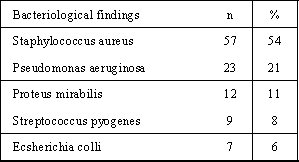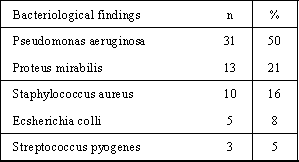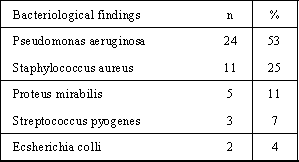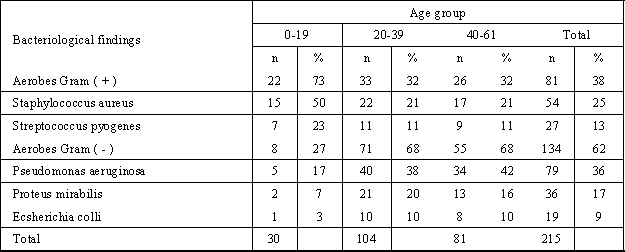

|
Journal Home Contents Preview Next |
Pro Otology
Balkan Journal of Otology & Neuro-Otology, Vol. 2, No 3:104-106 © 2002
All rights reserved. Published by Pro Otology Association
Chronic Otitis Media – Microbiological Findings
F. Jakimovska, M. Cakar, A. Lazarevski, A.Tudzarova, J. Clemmesen,
E. Dimitrovski
ENT Department, University Hospital, Skopje, Macedonia
ABSTRACT
Objective: The aim of the study was to emphasis that the microbiological. agents are one of the supporting factors developing chronic suppurative otitis media. The most frequently isolated bacteria were Pseudomonas aeruginosa, Proteus mirabilis and Staphylococcus aureus.
Study design: Investigation of 3 groups of patients: chronic suppurative otitis media, chronic suppurative otitis media with cholesteatoma, chronic suppurative otitis media with polyps.
Setting: The study was performed in the ENT department, University Hospital, Skopje, Macedonia
Patients: In our study we examineted 215 patients for bacteriological findings.
Intervention: Specimens were obtained by sterile cotton swabs.Microbiological technique with standard culture media was performed.
Results: There are 5 different species and all of them were aerobic. Three of them were Gram-negative and two of them were Gram-positive. The most frequently isolated bacteria were Pseudomonas aeruginosa, Proteus mirabilis and Staphylococcus aureus (more than 50%). Gram-negative bacteria increased in subjects of 20 years and above and Gram-positive bacteria increased in subjects younger than 19 years in examination according to the age group.
Conclusion: Microbiologic organisms may play a role in chronic suppurative otitis media. Clinical manifestation, course and prognosis of chronic otitis media depends on local infection and its treatment. The aim is to enable quick and right diagnosis and smart therapeutic choice in order to improve patients recovery and shorten treatment time as a financial benefit.
Keywords: Chronic supporative otitis media, Microbiological findings.
Pro Otology 3: 104-106, 2002
INTRODUCTION
Chronic otitis media represents a disease with still unexplained etiology. Anyway, in chronic suppurative otitis media many microbiological agents were isolated is one of its supporting factors. Suppuration continuing for longer period of time usually causes irreversible damage of the middle ear mucose and the underlying bone. These patients usually present themselves with otorrhea and hearing impairment.
If ventilation of the middle ear is obstructed, either by extrinsic Eustachian tube blockade, inflammation result of microbial infection or immunochemical events, middle ear effusion is produced.
Bacteriological finding in the chronic otitis media commonly has mixed infection of pyogenes bacteria, that cause feted of the effusion.
| Table 1. Distribution of cases with chronic suppurative otitis media according to the bacteriological findings. |

|
MATERIALS AND METHODS
In our study we examinated 215 patients for bacteriological finding at the ENT Department of University Hospital of Skopje. Specimens were obtained by sterile cotton swabs. The microbiological swabs were taken of 3 groups of patients:
• Chronic suppurative otitis media (108 cases)
• Chronic suppurative otitis media with cholesteatoma (62 cases) • Chronic suppurative otitis media with poliposa (45 cases)Microbiological technique with standard culture media was performed.
RESULTS
We analyzed 215 positive swab cultures. There are 5 different species and organisms and all of them were aerobic. There of them were Gram-negative and two of them were Gram-positive. In cases with chronic suppurative otitis media the most frequently isolated bacteria were Staphylococcus aureus (more than 50%) and Pseudomonas aeruginosa (Table 1).
In cases with chronic suppurative otitis media with cholesteatoma the most frequently isolated bacteria were Pseudomonas aeruginosa and Proteus mirabilis (Table 2).
In cases with chronic suppurative otitis media with polyps the most frequently isolated bacteria were Pseudomonas aeruginosa and Staphylococcus aureus (Table 3).
In this examination Gram-negative bacteria increased in subjects of 20 years and above and decreased in subjects between 0 and 19 years. Gram-positive bacteria decreased in subjects of 20 years and above and increased in subjects younger than 19 years (Table 4).
| Table 2. Distribution of cases with chronic suppurative otitis media with cholesteatoma according to the bacteriological findings. | Table 3. Distribution of cases with chronic suppurative otitis media with polyps according to the bacteriological findings. | |

|

|
DISCUSSION
Microbiological analysis of chronic otitis media shows an interaction between local infection and the disease. The predominant organisms are Pseudomonas aeruginosa and Staphylococcus aureus in our study.
The microbiology of chronic suppurative otitis media without cholesteatoma has been reported by Kenna and coworkers (1986). The most common bacterial species isolated was Pseudomonas aeruginosa, which was presented in 67 per cent.
The bacteriology of chronic otitis media with cholesteatoma has been reported (Harker, 1977; Brook, 1981). The most common aerobic microbiologic organisms isolated were Pseudomonas aeruginosa, Staphylococcus aureus and Proteus mirabilis.
It is important to make the distinction between chronic suppurative otitis media with and without cholesteatoma, since tympanomastoid surgery is indicated when cholesteatoma is present whereas medical management may be effective when cholesteatoma is absent.
By mechanisms not yet defined, certain upper respiratory tract bacteria localize and multiply within the middle ear space, causing an influx of polichromonuclear leukocitoses, a release of inflammatory mediators and the appearance of the purulent effusion.
In our study Gram-positive bacteria increased in subjects younger then 19 years probably depending on the influence of the bacterial flora in upper respiratory tract and the disease in that period.
Immunochemical and bacteriological investigations were carried out by Lin and associates. They found bacteria in 77 percent of effusions by means of a smear. Bacterial recovery rate was inversely related to the dramatic increase with age of IgA and IgG and lysosime levels in effusion.
Certain bacterial products may also play a role in middle ear inflammation and local immunologic responses. Bacterial products that have been implicated include capsular polysaccharide antigens, certain components of the bacterial cell wall, and oxidative and hydrophilic bacterial enzymes.
| Table 4. Bacterial distribution according to age group. |

|
CONCLUSIONS
Microbal organisams are one of the supporting factors in developing of the chronic otitis media.
Clinical manifestations, treatment, course and prognosis of chronic otitis media depends on local infection and its treatment.
Our study confirmed that the most common isolated bacteria are Pseudomonas aeruginosa, Staphylococcus aureus and Proteus mirabilis.
There are differences between age group in microbiological flora.
The aim is to enable quick and right diagnosis and smart therapeutic choice in order to improve patient’s recovery and shorten treatment time as a financial benefit.REFERENCES
Browning GG, Gatehouse S, Calder IT. Medical menagement of active chronic otitis media: A controlled study. Journal of Laryngology and Otology 1988;102:491-5.
Klein JO. Microbiology of otitis media. Ann Oto .Rhinol Laryngol 89 (Suppl 68) 1980;:98-101.
Kenna MA, Bluestone CD, Reilly JS. Medical management of chronic suppurative otitis media without cholesteatoma in children. Laryngoscope 1986;96(2):146-15.
Brook I. Aerobic and anaerobic bacteriology of cholesteatoma. Laryngoscope 1981;91:250-3.
Liu YS, Lim DJ, Lang R, et al. Microorganisms in chronic otitis media with effusion. Ann Otol Rhinol Laryngol 1976;85(25):245-9.
Liu YS, Lim DJ, Lang RW, Birck HG. Chronic middle ear effusions: Immunochemical and bacteriologic investigations. Arch Otolaryngol 1980;101:278-86.
|
Pro Otology |
Journal Home Contents Preview Next |